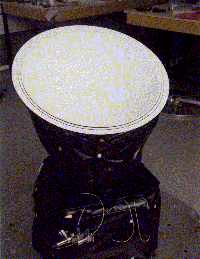


How do we control conduction in the design?
Conduction is about the transfer of energy by collisions between one particle and another. Consequently matter in any of its forms (gas, liquid, solid, plasma) will conduct heat to a lesser or greater extent. In general it is more effective in situations of higher density so we could expect solids to be good conductors. This is clearly not the whole story since we know that it is the metals which are the really good conductors rather than the non-metals which are insulators (this is why saucepans usually have a non-metallic handle). Spacecraft have a solid structure to give it strength and rigidity so conduction will always occur. We control the effectiveness of the conduction through our choice of materials and by controlling their geometry. For example a short, thick rod of any material is a better conductor than a long, thin rod of the same material. However any design has to be consistent with the mechanical constraints and the mass constraints.![]()
How do we control radiation in the design?
Radiation is also to do with the transfer of heat through collisions, but this time between particles and photons (particles of light). The radiative heat coupling between different components can be controlled through the geometry of the radiating elements and the surface finish of the elements. For example a surface with a large area is a better radiator/receiver than one with a small area. Also rough surfaces are good radiators/receivers whereas shiny, polished surfaces are good reflectors which therefore do not absorb energy and so are not good radiators/receivers. Besides direct treatment of surfaces we can use paints and tapes which adhere to the radiating surface.
IMAGE - The EPIC Camera as shown on the Design and Instrumentation page but with MLI blankets included.
However to make a surface very insulating in the radiative sense we have to cover it with a blanket which is made up of multiple layers of very thin, very shiny foils made of plastic material very similar to that from which crisp packets are made. Indeed you may have seen marathon runners being covered in a single layer of such a foil at the end of the race. Often you will see pictures of spacecraft which have these multilayer blankets on the outside of them.![]()
Are there any other ways of controlling spacecraft temperatures?
Yes; there are quite a large number of rather more sophisticated ways of controlling temperatures though perhaps not quite as elegant. These are so-called active heating and cooling devices which have to be electrically powered. An example of the former is a heater mat which operates like an electric fire but at a much lower power. An example of the latter is cryogenic device which operates much like a conventional refrigerator.![]()
How are the temperatures of the CCDs on XMM controlled?
Here we use a multi-stage, passive radiator to cool the CCDs to a very low temperature in combination with a local heater to actually control the temperatures to selected values above this. Electronics monitors the temperature and brings the CCDs to the required temperature by controlling the heater power.![]()
How does a multistage, cooling radiator work?
One of the problems about cooling specific detectors on spacecraft is that not only does the internally generated heat of the detector have to be radiated away but also the parasitic power which consequently comes into the cooled device from its now warmer surroundings. This parasitic power is radiated in from the warm surrounding surfaces and conducted in along the electrical wires to the detector itself. The multistage radiator works on the principle of intercepting the warm radiation from the surroundings by means shrouds which enclose the detector and dumping that power to space directly with a radiator dedicated to the shroud before the warm radiation reaches the cooled detector. The principle can be repeated in a nest of such shrouds and radiators surrounding the detector. By dividing up the total available radiating area in this way is a more efficient use of this area. This is so because the rate at which heat can be radiated from a surface is proportional to the 4th power of its temperature and not simply to its temperature.[Stefan's law is P=sAT4 where P is the power, A is the surface area, T is the temperature and s is the constant of proportionality and is called Stefan's constant].
Use Stefan's law to show mathematically that this is the case. Please click here for help.The end of the Thermal design and Temperature Control section.

